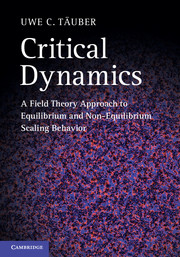Book contents
- Frontmatter
- Dedication
- Contents
- Preface
- Part I Near-equilibrium critical dynamics
- 1 Equilibrium critical phenomena
- 2 Stochastic dynamics
- 3 Dynamic scaling
- 4 Dynamic perturbation theory
- 5 Dynamic renormalization group
- 6 Hydrodynamic modes and reversible mode couplings
- 7 Phase transitions in quantum systems
- Part II Scale invariance in non-equilibrium systems
- Index
- References
6 - Hydrodynamic modes and reversible mode couplings
from Part I - Near-equilibrium critical dynamics
Published online by Cambridge University Press: 05 June 2014
- Frontmatter
- Dedication
- Contents
- Preface
- Part I Near-equilibrium critical dynamics
- 1 Equilibrium critical phenomena
- 2 Stochastic dynamics
- 3 Dynamic scaling
- 4 Dynamic perturbation theory
- 5 Dynamic renormalization group
- 6 Hydrodynamic modes and reversible mode couplings
- 7 Phase transitions in quantum systems
- Part II Scale invariance in non-equilibrium systems
- Index
- References
Summary
Equipped with the field theory representation of non-linear Langevin equations, the tools of dynamic perturbation theory, and the dynamic renormalization group introduced in Chapters 4 and 5, we are now in the position to revisit models for dynamic critical behavior that entail reversible mode couplings and other conserved hydrodynamic modes. We have already encountered some of these in Section 3.3. In models C and D, respectively, a non-conserved or conserved n-component order parameter is coupled to a conserved scalar field, the energy density. Through a systematic renormalization group analysis, we may critically assess the earlier predictions from scaling theory, and discuss the stability of fixed points characterized by strong dynamic scaling, wherein the order parameter and conserved non-critical mode fluctuate with equal rates, and weak dynamic scaling regimes, where these characteristic time scales differ. Next we investigate isotropic ferromagnets (model J), with the conserved spin density subject to reversible precession in addition to diffusive relaxation. Exploiting rotational invariance, we can now firmly establish the scaling relation z = (d + 2 − η)/2. Similar symmetry arguments yield a scaling relation for the dynamic exponents associated with the order parameter and the non-critical fields in the O(n)-symmetric SSS model that encompasses model E for planar ferromagnets and superfluid helium 4 (for n = 2), and model G for isotropic antiferromagnets (n = 3). There exist competing strong- and weak-scaling fixed points, with the former stable to one-loop order, and characterized by z = d/2 for all slow modes.
- Type
- Chapter
- Information
- Critical DynamicsA Field Theory Approach to Equilibrium and Non-Equilibrium Scaling Behavior, pp. 207 - 250Publisher: Cambridge University PressPrint publication year: 2014

